Related Research Articles

A climbing route is a path by which a climber reaches the top of a mountain, a rock face or an ice-covered obstacle. The details of a climbing route are recorded in a climbing guidebook and/or in an online climbing-route database. Details recorded will include elements such as the type of climbing route, the difficulty grade of the route–and beta on its crux(es)–and any risk or commitment grade, the length and number of pitches of the route, and the climbing equipment that is needed to complete the route.

Glossary of climbing terms relates to rock climbing, mountaineering, and to ice climbing.

Ice climbing is a climbing discipline that involves ascending routes consisting of frozen water. To ascend, the ice climber uses specialist equipment, particularly double ice axes and rigid crampons. To protect the route, the ice climber uses steel ice screws that require skill to employ safely and rely on the ice holding firm in any fall. Ice climbing routes can vary significantly by type, and include seasonally frozen waterfalls, high permanently frozen alpine couloirs, and large hanging icicles.
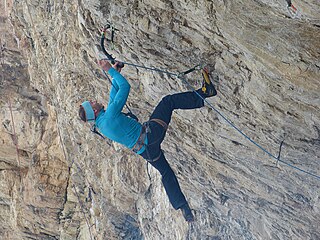
Dry-tooling is a form of mixed climbing that is performed on bare, ice-free, and snow-free, routes. As with mixed climbing, the climber uses ice tools and crampons to ascend the route, but uses only rock climbing equipment for protection; many modern dry-tooling routes are now fully bolted like sport climbing routes. Indoor ice climbing competitions are held on non-ice surfaces and are effectively dry-tooling events.

Solo climbing, or soloing, is a style of climbing in which the climber climbs a route alone, without the assistance of a belayer or being part of a rope team. By its very nature, solo climbing presents a higher degree of risk to the climber, and in some cases, particularly where the climber is also not using any form of climbing protection, it is considered an extremely high-risk activity.

Chris Omprakash Sharma is an American rock climber who is considered one of the greatest and most influential climbers in the history of the sport. He dominated sport climbing for the decade after his 2001 ascent of Realization/Biographie, the world's first-ever redpoint of a consensus 9a+ (5.15a) graded route, and ushered in what was called a "technical evolution" in the sport. Sharma carried the mantle of "world's strongest sport climber" from Wolfgang Güllich, and passed it to Adam Ondra.
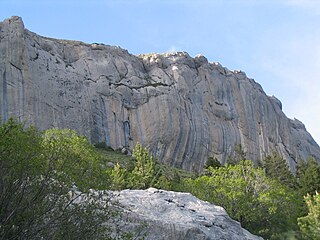
Realization, also called Biographie, is a circa 35-metre (115 ft) sport climbing route on an overhanging limestone cliff on the southern face of Céüse mountain, near Gap and Sigoyer, in France. After it was first climbed in 2001 by American climber Chris Sharma, it became the first rock climb in the world to have a consensus grade of 9a+ (5.15a). It is considered an historic and important route in rock climbing, and one of the most attempted climbs at its grade.

Black Rocks, is a small outcrop of ashover gritstone, between Cromford and Wirksworth in Derbyshire, the Peak District, England. It is an important crag in the history of British rock climbing, and has some of the most extreme climbing routes in Britain, including Gaia E8 6c.
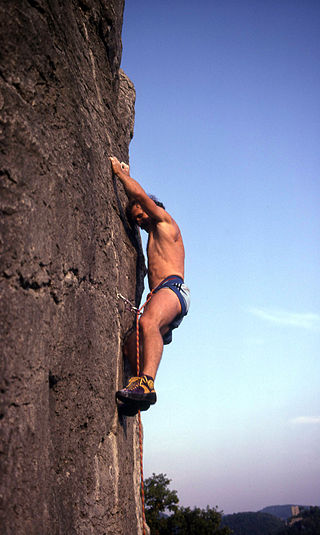
In rock climbing, a redpoint is the free-climb of a route by lead climbing where the climber never used the rope, or any other artificial aids such as their climbing protection, to hold any of their weight during the climb. The climber is allowed to have practiced the route many times beforehand — such as by headpointing or by top roping — and/or to have failed on numerous previous attempts.
Steve McClure is a British rock climber and climbing author, who is widely regarded as Britain's leading and most important sport climber for a period that extends for over two decades, starting from the late 1990s. In 2017, he created Rainman, Britain's first-ever 9b (5.15b) sport route, and by that stage was responsible for developing the majority of routes graded 9a (5.14d) and above in Britain. Although mainly known for sport climbing, McClure has also been one of the most successful British traditional climbers, and British onsight climbers.

Deep-water soloing (DWS), also known as psicobloc, is a form of free solo climbing where any fall should result in the climber landing safely into deep water below the route. DWS is therefore considered safer than normal free solo climbing, however, DWS brings several unique additional risks including trauma from uncontrolled high-speed water entry, injury from hitting hazards above and below the water while falling, and drowning in rough or tidal seas, and is thus considered riskier than normal bouldering.
Lisa Rands is an American rock climber. She is known for her bouldering for which in 2002, she became the first American female to win IFSC World Cup bouldering competitions, and topped the IFSC world boulder rankings in 2002. Rands was the first American female to climb boulders of grade V11 (8A), and V12 (8A+), and was the second-ever female in history to climb a 7C+/8A boulder. As well as making first female ascents (FFAs) of boulders such as The Mandala V12 (8A+), Rands was the first female in history to do an E8-graded traditional climbing route, The End of the Affair.
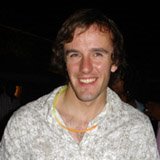
Dave MacLeod is a Scottish rock climber, ice climber, mixed climber, and climbing author. MacLeod is known for being the second-ever person to free solo a 8b+ (5.14a) graded route, and for climbing one of the hardest traditional climbing routes in the world.

Ailladie, is an 800-metre-long (2,600 ft) west-facing limestone sea cliff, that varies in height from 8 metres (26 ft) to 35 metres (115 ft), situated on the coast of The Burren in County Clare, Ireland. Ailladie is one of Ireland's most highly regarded rock-climbing locations, particularly for high technical grade single pitch traditional climbing routes and deep-water soloing routes. It is also a location for shore-angling competitions, and, with its cliffs and view of the Aran Islands, is a popular photography stop for tourists.
Sonnie Trotter is a Canadian professional climber, known for his strength in many rock climbing disciplines – particularly traditional climbing – and contributing to hundreds of first free ascents around the world.

Es Pontàs is a natural arch made from limestone in the southeastern part of the island of Mallorca in Spain. The arch is located on the coastline between the Cala Santanyí and Cala Llombards in the municipality of Santanyí, and is approximately 20 metres (66 ft) in height. Es Pontàs is only accessible by boat or by swimming, and is a popular scenic location for tourists to Mallorca who view it from the 'Mirador Es Pontas'.
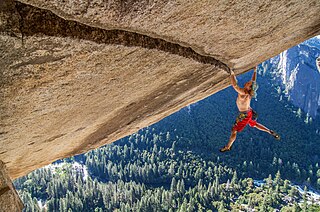
Separate Reality is a 66-foot (20 m) traditional climbing route in Yosemite National Park in California. The route is known for its exposed and dramatic crux that consists of a 20-foot (6.1 m) long crack in its horizontal roof. When it was first free-climbed by Ron Kauk in 1978, it was one of the first climbs in the world to have a grade of 7a+ (5.12a). In 1986, German climber Wolfgang Güllich free soloed the route, and the photographs by Austrian Heinz Zak became iconic in rock climbing history.

Mixed climbing is a climbing discipline used on routes that do not have enough ice to be pure ice climbs, but are also not dry enough to be pure rock climbs. To ascend the route, the mixed climber uses ice climbing equipment, but to protect the route, they use both rock-climbing equipment and ice climbing equipment. Mixed climbing varies from routes with sections of thick layers of ice and sections of bare rock, to routes that are mostly bare rock but which are "iced-up" in a thin layer of ice and/or snow.

Jonathan Siegrist is an American rock climber who is regarded as one of the world's most prolific extreme sport climbers, and who has redpointed, and made numerous first free ascents, of a large number of sport climbing routes at and above the grade of 9a (5.14d). Siegrist's breadth of experience at the world's most extreme sport climbing grades, means that he is often looked to for guidance regarding the grading of extreme sport routes in America. While principally known as a sport climber, he has repeated some of the world's hardest traditional climbing routes.

Es Pontàs is a 20-metre (66 ft) long limestone deep-water soloing (DWS) climbing route on the Es Pontàs sea-arch in Mallorca, Spain. After it was first free soloed in September 2006 by American climber Chris Sharma, it became graded at 9a+ (5.15a) – the world's first-ever DWS route at that grade, and one of the earliest 9a+ graded rock climbs of any type in history. Es Pontàs was credited with promoting the emerging sport of DWS, and further enhancing Sharma's reputation and legacy as a pioneer in rock climbing. Sharma's first ascent was featured in the award-winning 2007 climbing film, King Lines.
References
- 1 2 3 4 5 Sterling, Sarah. "Tim Emmett: life as an adventurous 42-year-old dad". British Mountaineering Council . Retrieved 21 December 2021.
- ↑ "TV extreme sport star Tim Emmett to perform at The Brewhouse". Somerset County Gazette . 9 October 2012. Retrieved 21 December 2021.
- 1 2 3 4 "Mountain Hardwear and Tim Emmett's Smart Decisions on Everest". Gripped.com. 8 October 2019. Retrieved 21 December 2021.
- 1 2 "Watch the Best Deep Water Soloing Film of 2020". Gripped.com. 5 December 2020. Retrieved 21 December 2021.
- 1 2 "A History of Mallorca Deep Water Soloing". British Mountaineering Council . 8 March 2011. Retrieved 21 December 2021.
- 1 2 "Deep Water: Psicobloc in Vietnam with Kyra Condie and Tim Emmett". Outside . 14 August 2020. Retrieved 21 December 2021.
- ↑ Levy, Michael (19 February 2020). ""Mission to Mars" Is Tim Emmett and Klem Premrl's New WI 13 (What?!) at Helmcken Falls". Rock&Ice. Retrieved 21 December 2021.
- ↑ Gray, Will (9 December 2021). "These are the 10 hardest climbs in the world". RedBull. Retrieved 21 December 2021.
- 1 2 Laeser, Luke (1 November 2007). "20 Questions with Tim Emmett". Outside . Retrieved 21 December 2021.
- ↑ "Red Bull White Cliffs 2015: The Results". RedBull.com. 5 December 2015. Retrieved 21 December 2021.
- ↑ "Tim Emmett Sends Superman 5.14c on West Coast". Gripped.com. 25 May 2017. Retrieved 21 December 2021.
- ↑ "Tim Emmett and Read Macadam Send The Path 5.14R in Rockies". Gripped.com. 21 July 2016. Retrieved 21 December 2021.
- ↑ Wilson, Simon (10 June 2010). "Tim Emmett - Pembroke E10 - Full Story (Video)". UKClimbing.com. Retrieved 21 December 2021.
- ↑ Griffin, Lindsay (7 November 2006). "EMMETT AND PARNELL CLIMB MAJOR GANGOTRI ROCK ROUTE". Alpinist . Retrieved 21 December 2021.
- 1 2 Ryan, Michael (31 January 2006). "Review: Dosage 3 by Big Up Productions". UKClimbing.com. Retrieved 22 December 2021.
- ↑ Brown, Dave (9 November 2009). "Welsh Connections – Trailer". Outside . Retrieved 22 December 2021.
- ↑ "Mountain". MNTNFILM Database. 2017. Retrieved 22 December 2021.
- ↑ "The Julia Bradbury Collection ticklist". UKClimbing.com. 2007. Retrieved 21 December 2021.
- ↑ "Dave MacLeod reveals Great Climb fears". BBC News . 3 December 2010. Retrieved 21 December 2021.
- ↑ "Top Gear: Jeremy Clarkson vs. Leo Houlding". Outside . 2005. Retrieved 21 December 2021.
- ↑ Gresham, Neil; Emmett, Tim (15 October 2005). Preposterous Tales: The International Climbing Escapades of Neil Gresham, Tim Emmett and Friends. Cordee. ISBN 978-1904207375.